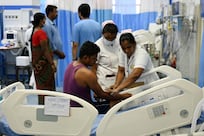DUBAI // New procedures have shaved more than an hour and a half off the long queues for Filipinos to get an exit clearance.
Previously, the process to obtain an overseas employment certificate (OEC) had taken about three and a half hours at the Philippine overseas labour office in Dubai. Now, it takes less than two hours.
In addition to shorter waiting times, "we've changed the layout of the office so people are now seated and do not need to stand in a queue", said Delmer Cruz, the new Filipino labour attache in Dubai.
More improvements have been planned.
The OEC is issued by the Philippine overseas labour office in Abu Dhabi or Dubai, for a fee of Dh10. Filipinos returning from holiday in their home country must secure this certificate before they leave the country to prove they have been legally hired.
Before obtaining the certificate, applicants must be members of the Overseas Workers Welfare Administration (OWWA) - at a cost of Dh92 for two years. They must also be members of the Home Development Mutual Fund, known as the Pag-Ibig Fund, at a cost of at least Dh10 a month.
The process to get a certificate involved filling out three forms - for Pag-Ibig Fund, OWWA and OEC - and queuing at different counters to pay. If an applicant's OWWA membership is still valid, he or she can just apply for an OEC and Pag-Ibig membership.
Mr Cruz and his staff devised ways to fast-track the service two weeks ago.
Previously, applicants had to queue at the OWWA counter and then move on to the OEC counter.
"We studied the waiting period and decided to adopt a bank-teller style," he said. "Now, we have three counters and each staff can process OWWA and OEC applications at the same time."
A fourth counter is dedicated to processing the Pag-Ibig Fund membership.
An electronic queuing system is expected to be in place by the end of this year. Currently, applicants are handed a "client number". Then, they take their seats and wait for their turn at each of the four counters.
Mr Cruz tested the service on August 2 to see what changes were still needed.
He and the assistant labour attache, Venus Abad, queued along with 300 Filipinos for the certificate.
He noticed some confusion and restlessness in the crowd, but it took him two hours and 14 minutes to get through the entire process.
Since then, the office has added another staffer to process OEC applications.
On any given weekday in June and July, the office receives up to 400 applications for the OEC and other services. The numbers usually fall in August, but rise to a peak of 500 to 600 a day in November and December. That is when many Filipinos return home for the Christmas and New Year's holidays.
"I believe 80 per cent of Filipinos here have access to the internet," Mr Cruz said. "To speed up the process, we encourage them to download and fill out the forms before heading to the labour office."
Details on how to get an OEC are available at polo-owwadubai.net, where applicants can also download OWWA, OEC and Pag-Ibig Fund membership forms.





